Views: 195
 The small garden between the church and the street used to be a cemetery. It is still occupied by a mausoleum built in 1708 for the Suzin’s family
The small garden between the church and the street used to be a cemetery. It is still occupied by a mausoleum built in 1708 for the Suzin’s family
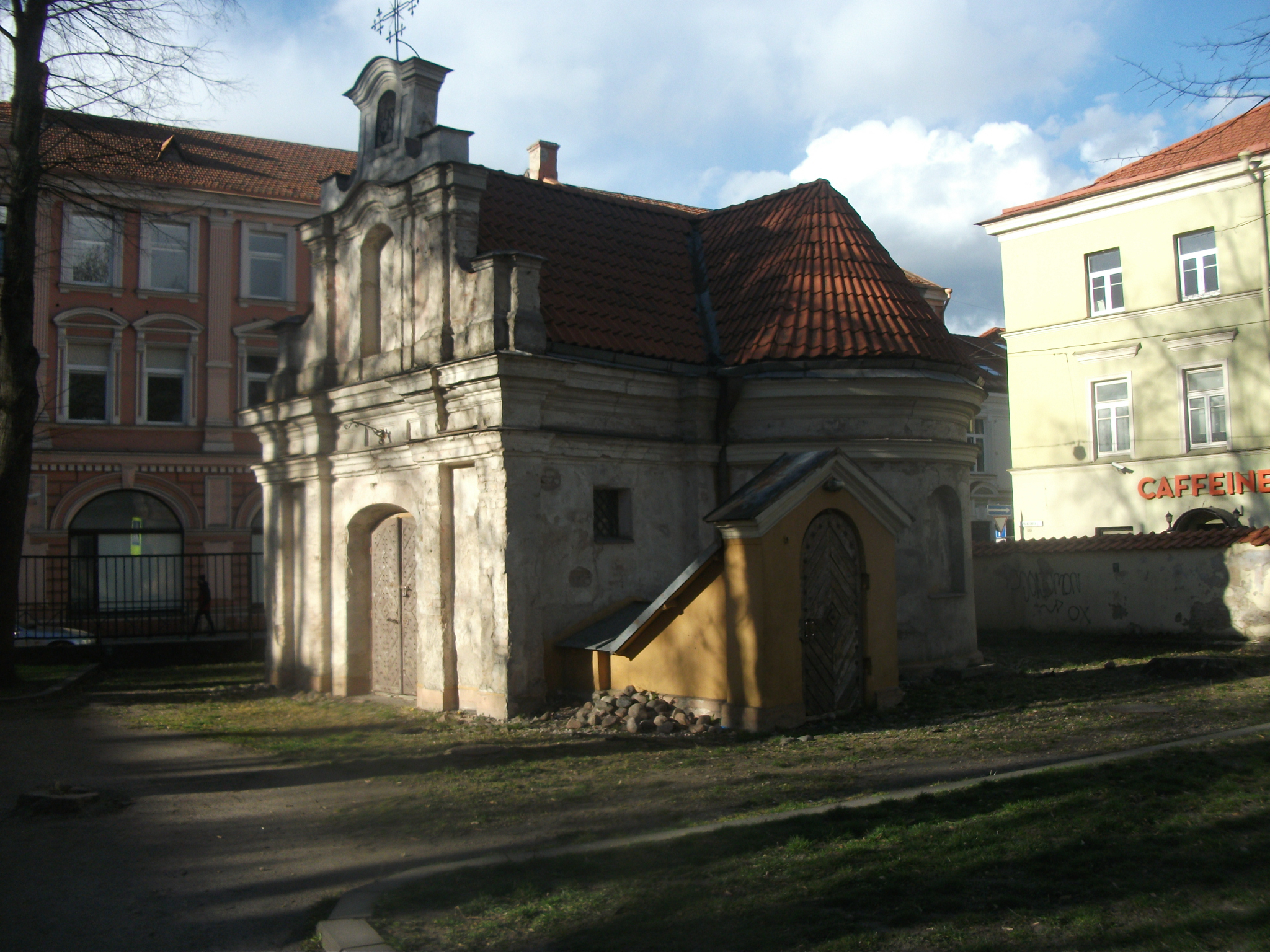 The Suzin’s family chapel was functioning as a souvenir shop during the Soviet administration
The Suzin’s family chapel was functioning as a souvenir shop during the Soviet administration
 The Suzin’s family mausoleum chapel is located on the corner of Trakų St. and Franciscan St. in the Old Town in Vilnius
The Suzin’s family mausoleum chapel is located on the corner of Trakų St. and Franciscan St. in the Old Town in Vilnius
All photos are copyrighted by Vladislav B. Sotirovic
© Vladislav B. Sotirovic 2020
RELATED POSTS
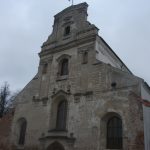
The church is Gothic, with some Baroque forms that it acquired in the late 18th centuryIn 1812 the church was partly destroyed by the French army that used it as a granary. Since 1864 the church was closed and converted into an archive The church adjoins a monastery, the oldest in Lithuania, whose construction began in Gediminas' times (in 1334)All photos are copyrighted by Vladislav B. Sotirovic© Vladislav B. Sotirovic 2018
Continue Reading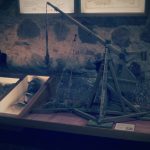
Althought it appears quite large from the outside, the thikness of the tower's walls make it a relatively small exibition space. Its floors hold various items of weaponry and engravings, and models which give an idea of how the site looked and was used in earlier timesThere are models of the three castles from the 14th and early 17th century. They provide an interesting comparison, to show how the site developedThe focal attraction of the museum is the view from the roof, and a narrow staircase leads visitors up to a parapet that overlooks the entire center of the city. This is the best place from which to appreciate the variety of colours of the Old TownAll photos are copyrighted by Vladislav B. Sotirovic© Vladislav B. Sotirovic 2020
Continue Reading
One house in Augustijonų Street in Vilnius Old Town. Behind the house is the Church of Our Lady, Comfort of the AfflictedA view from Augustijonų Street on the top of the tower of the Church of Our Lady, Comfort of the Afflicted. This church used to be known for its lavish decoration, but the altars, pulpit, and organ were removed in 1852 when it was transformed into a Russian Orthodox Church One courtyard in Augustijonų Street in front of the Church of Our Lady, Comfort of the AfflictedAll photos are copyrighted by Vladislav B. Sotirovic© Vladislav B. Sotirovic 2019
Continue Reading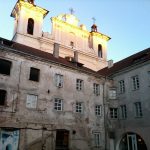
In Old Town in Vilnius, at the Church of the Holy Spirit, on St. Ignatius St., a Dominican monastery was established in 1501At the time of Napoleonic Wars (in 1812) the Dominican monastery of the Church of the Holy Spirit was used by the French army as a hospitalThe monastery was converted into a prison by the Russian authorities in 1807. Corridors are decorated by frescoes from the 18th centuryAll photos are copyrighted by Vladislav B. Sotirovic© Vladislav B. Sotirovic 2021
Continue Reading
S. Skapo Street marks the northern limit (right) of the Vilnius University Old CampusA nice perspective view of de Reuss Palace seen from S. Skapo Street (west side) The Lopaciński or Sulistrowski estate in S. Skapo Street. The building got its Classical style according to Martin Knackfuss project. In 1930, the west wing was refurbished as the bishop's house. From 1940, the building housed a music schoolAll photos are copyrighted by Vladislav B. Sotirovic© Vladislav B. Sotirovic 2020
Continue Reading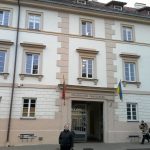
Hostel Courtyard of the Old Campus of the Vilnius UniversityIn the late 19th century all houses of the courtyard were reconstructed and in the early 21st century water supply and sewerage systems were installed. Apartments were rented in those housesInterior of the present-day Faculty of Philosophy. After the reconstruction was completed in the spring of 2005, the Faculty of Philosophy was relocated hereAll photos are copyrighted by Vladislav B. Sotirovic© Vladislav B. Sotirovic 2023
Continue Reading
The Jewish Str. in Vilnius was known as hosted the Great Synagogue of Vilnius, the Jewish (Strashun) Library of Vilnius, the Schulhoyf yard, the Gaon House and the Gaon Synagogue among other buildings Gaon Str. with the Stikliai (Glass) Hotel on the corner of the Glass Square where the glass products have been sold since the mid-16th centuryAt the entrance to Gaon Str. in 1941 it was the gate to the Small Jewish Ghetto which existed from September 6th to October 29, 1941. The Small Jewish Ghetto had around 11.000 inhabitantsAll photos are copyrighted by Vladislav B. Sotirovic© Vladislav B. Sotirovic 2019
Continue Reading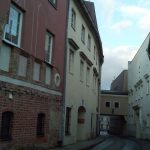
A former Gothic façade that was uncovered at Karmelitų Str. around Rūdninkų Square in the Old Town of VilniusThe back-side façade from the inner courtyardThe back-side façade from the inner courtyard. The house is located on the territory of WWII Large Jewish GhettoAll photos are copyrighted by Vladislav B. Sotirovic© Vladislav B. Sotirovic 2020
Continue Reading
This short (250 m), narrow and crooked street with Baroque and Classical houses is surrounded by curving, walls, ancient façades and typical 17th and 18th-century courtyardsIn Bernardinų St. in the house No. 11 a famous Polish-Lithuanian poet Adam Mickiewicz lived in April-June 1822. His apartment is located on the left side of the ground floor which is today transformed into the museumBernardinų St. connects the ensemble of the Churches of St. Anne and Bernardines with Pilies St. In 16th century, it was a section of a road connecting the complex of royal castles with the Bernardinų Gate of the cuty defensive wall All photos are copyrighted by Vladislav B. Sotirovic© Vladislav B. Sotirovic 2020
Continue Reading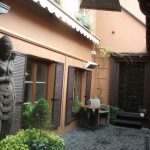
The building of Vilnius Gymnasium of Vytautas the Great - the first gymnasium in Lithuanian language est. in Vilnius at the beginning of the 20th centuryThe backside of the Church of Our Lady, Comfort of the Afflicted seen from Augustijonų Street in Vilnius Old Town. In Soviet times the church was used as a warehouse, and in 1967 the interior was divided into several shops by the construction of concrete floors. The building is today in urgent need of restorationThe entrance to the Jesuit Gymnasium in Augustijonų Street in Vilnius Old Town. Behind the gymnasium is St. Casimir ChurchAll photos are copyrighted by Vladislav B. Sotirovic© Vladislav B. Sotirovic 2019
Continue Reading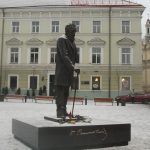
A monument to dr. Jonas Basanavičius in Vilnius in front of the building of the Lithuanian National PhilharmonicDr. Jonas Basanavičius chaired the session of Lithuanian Council that adopted the Act of Independence of Lithuania on 1918-02-16. He was the first to sign the Act of the Proclamation of the Lithuanian IndependenceBalancing between Lithuanian and Polish interests, he refused to participate in the opening of the Polish Stefan Batory University (today Vilnius University)All photos are copyrighted by Vladislav B. Sotirovic© Vladislav B. Sotirovic 2020
Continue Reading
In the mid-19th century, Russian architect Nikolaj Chagin added a portal with statues of the Atlantes. In this palace Eustachy Tyszkiewicz held part of his archaeological collections that constituted the basis of the Museum of Antiquities (the first public museum in Vilnius) In 1863, it was a secret gattering place of the Lithuanian-Polish rebels against the Russian administration There is the Tyszkiewicz family coat of arms on the pediment - an aristocratic family who owned extensive estates in Lithuania. At the present time, the building is occupied by the Vilnius Gediminas Technical University (VGTU)All photos are copyrighted by Vladislav B. Sotirovic© Vladislav B. Sotirovic 2020
Continue Reading
The fortifications at the top of Tower St. have been restored and today form the Bastion Museum of the original early 17th century BarbecanA view from Tower St. on St. Casimir church (early 17th century Baroque style)Tower St. with the building of the former Augustine monastery (left)All photos are copyrighted by Vladislav B. Sotirovic© Vladislav B. Sotirovic 2020
Continue Reading
The garden reminiscent of a so-called secret garden (giardino segreto) could have been planned in the style of an Italian parkThe Renaissance Garden was located between the Royal Palace and the Upper Castle with the Tower of Gediminas. The stairs and other elements were designed by the Italian architect and sculptor Bernardino Zanobi da Gianottis. An Italian priest, Francesco, took care of the garden plantsEvidence of the history of the garden lies in the relics from various periods that survived in the cultural layers of the Lower Castle with the Renaissance Royal PalaceAll photos are copyrighted by Vladislav B. Sotirovic© Vladislav B. Sotirovic 2020
Continue Reading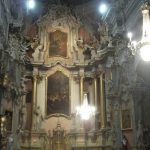
The interior od the church is in the Rococo style with the exception of the Pac Chapel, which is late Baroque in the exterior, and rather Classical in the interior Impressive, gently-curved church pulpit in the Rococo style is created from wood and gold-plated tin in the second half of the 18th centuryThe church's mural painting is the only one of its size remaining in Lithuania. One arch depicts 19 scenes from St. Theresa's lifeAll photos are copyrighted by Vladislav B. Sotirovic© Vladislav B. Sotirovic 2020
Continue ReadingChurch of the Assumption of the Holy Virgin Mary and the Franciscan Monastery
Vilnius Castle Museum (Western Tower of the Upper Castle)
Augustijonų Street (I)
A Dominican Monastery at the Church of the Holy Spirit
S. Skapo Street
Bursa (Student Dormitory) Courtyard at Vilnius University’s Old Campus
The Jewish Street and Gaon Street in the Old Town of Vilnius
House-Monument with Gothic Façade
Bernardinų Street in Vilnius
Augustijonų Street (II)
Jonas Basanavičius Monument in Vilnius
Tyszkiewicz Estate in Trakų St. 1 in Vilnius
Tower St. (Bokšto g-ve) in Vilnius
The Renaissance Palace Garden in Vilnius
Church of St. Theresa (Interior)



